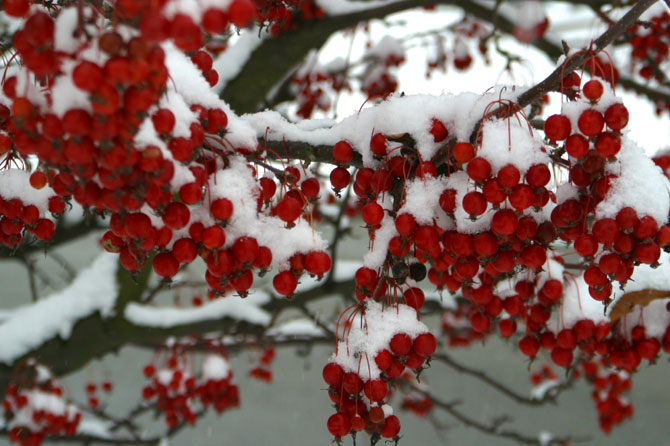Winterizing the Garden
 Top Ten List for Inspiring Winterizing.
Top Ten List for Inspiring Winterizing.
1. Spend a golden, autumn day in the vegetable garden. The way our winters have been quickly descending on us, this could be a last opportunity to soak up the warm sun- shine. While you are absorbing the rays and vitamin D, pull out all vegetation. Then cover the ground with aged manure and compost. Later you may also want to add weed barrier. Your friendly earthworms begin to incorporate the manure and compost into your soil. When spring arrives, you can remove the weed barrier and your garden space will be ready for planting.
2. Till organic mulch into or add organic matter to flower beds. Dig up herbaceous tubers such as cannas and dahlias. It is also a good time to divide and move perennials. Then use a light hand when cleaning out the beds. Sure, you want to remove the most unsightly and sad looking remnants of summer, but leave some flower seed heads and decorative grass stems. These will provide food for the birds and other wild life, as well as interesting visual effects for you to admire when Jack Frost or Suzy Snowflake visit your garden.
3. As you empty and clean all containers, remember to take cut- tings of ivy, geraniums and other plants. Unless unhealthy discarded plants can be placed in the compost pile. Potting soils and compounds can be put into the compost pile or in with the mulch in your cleared out vegetable patch. This is also a good time to discard faded plastic pots so you won’t be tempted to use them next year. Broken terra cotta and ceramic pots can be cleaned and broken up to provide drainage in next year’s containers.
4. If you have not already done so, record this year’s knock out plant combinations and successes along with the not-so successful plants and locations. Also, decide now where you might try that new plant combination you observed and jotted down during the last growing season. It is also a good time to mark bare spots in your beds. On a plastic plant label, write the name of the plant, seed or bulb you will insert at this location next year.
5. Each time you shop at garden and variety stores, check the sale rack for garden containers and accessories. If you see something you need or like, buy it now! It probably won’t be there when you want it in May. I am still kicking myself because I did not buy the two semi-circular planters I saw last January or the “around the pole pots” I later found when searching for the first items. Twenty stores and 10 months later, I still haven’t been able to find either.
6. When purchasing and planting hardy bulbs for spring blooms, save a few for forcing. If you plant and place them in the refrigerator now, they will be ready to grace your table or window sill at Christmas or on Valentine’s Day. As you are planting your bulbs outdoors, visualize how you will enjoy dishes of bright red tulips, regal purple crocus or sunny jonquils on a cold winter afternoon. Check your favorite garden book or the bulb package for directions on forcing.
7. Consider which yard and garden accessories you might leave out all winter. Water features must be emptied, cleaned and stored, but sundials, obelisks, concrete objects, etc. can be left out for visual interest. Sometimes they look even more intriguing with a covering of frost or snow.
8. Sow a package of native Missouri wildflower seeds. Some of these seeds actually germinate during the winter months. This will not provide instant gratification, but the process of watching each seed sprout and grow in its own time will provide several months of wonder. Native Missouri wildflower seeds are available at several nurseries listed in the Grow Native website (www.grownative.org).
9. Make a brush pile for the birds and other wildlife. Situated near your bird feeders and birdbath, the brush pile provides shelter, and it attracts insects and worms. Instant bird snacks!
10. Plant a winter garden and decorate it with clear lights. The plants will provide some interesting viewing during the day, while the lights add some sparkle to the long winter evenings. When the local nurseries are still open, select a few four-season perennials and shrubs such as rhododendron, hydrangea, winterberry, azalea, prostrate blue spruce, ‘Autumn Joy’ sedum and ornamental grasses. Plant them where they can be easily seen from a cozy window seat, the table where you enjoy your morning coffee or your computer desk. A concise winter garden planting guide is included in Katherine Whiteside’s, The Way We Garden Now. She also suggests The Unsung Season by Sydney Eddison and The Garden in Winter, by Rosemary Verey for detailed plants lists and photographs for inspiration. All are available at the local library or bookstores.
Pull out your most comfortable gardening garb and get ready for some inspiring winterizing. When you get tired, picture yourself on a cold January afternoon wishing you could be digging in the dirt. Then remember the immortal words of Percy Bysshe Shelley’s Ode to the West Wind,
“Oh Wind, If Winter comes, can Spring be far behind?”
Written by Majorie Yates



Leave a Reply
You must be logged in to post a comment.